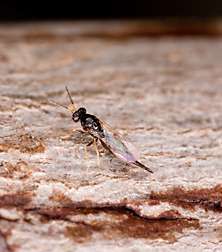Developing biocontrols to contain a voracious pest

U.S. Department of Agriculture (USDA) scientists are playing a key role in efforts to contain the emerald ash borer's destructive march through the nation's forests.
Researchers with USDA's Agricultural Research Service (ARS) are testing a fungal pathogen that could be used as a biocontrol, along with the release of non-stinging wasps that are the beetle's natural enemies. Wasps have been released in Michigan, Illinois, Indiana, Ohio, West Virginia and Maryland, and releases are planned in several other states.
John Vandenberg, an entomologist with the ARS Robert W. Holley Center for Agriculture and Health in Ithaca, N.Y., is evaluating Beauveria bassiana, a fungus that is the active ingredient in a commercially available insecticide. Researchers have found that the fungus helps to control emerald ash borer beetles when it is applied to infested trees before wasps are released.
Results, published in the journal Biological Control, show the fungus kills beetles and persists better on bark than on leaves. More recent work shows the fungus does not harm the wasps. ARS is the USDA's principal intramural scientific research agency, and the research supports USDA's commitment to agricultural sustainability.
The beetles were first detected in the United States near Detroit, Mich., in 2002 and have since wiped out huge swaths of ash trees in forests and tree-lined neighborhoods. Along with the ecological implications, ash trees are used to make furniture, tool handles, baseball bats, and other wood products.
In other work, Jian Duan, an entomologist at the ARS Beneficial Insects Introduction Research Unit in Newark, Del., is working with state and federal partners to determine how well the three wasp species being released, Oobius agrili, Tetrastichus planipennisi, and Spathius agrili, are surviving the winter in different Northeastern habitats and whether any one of the wasps is more effective than the others.
Duan also recently published a preliminary assessment focused on whether the wasps were able to become established in three stands of natural forests in Michigan. His findings, published in the journal Environmental Entomology, showed that at least one of the wasps (T. planipennisi) had become established in three release sites in Michigan, and that T. planipennisi was the most abundant species of parasitoid wasps attacking emerald ash beetle larvae a year after release.
More information: Read more about this research in the April 2011 issue of Agricultural Research magazine: www.ars.usda.gov/is/AR/archive/apr11/pest0411.htm
Provided by United States Department of Agriculture
















